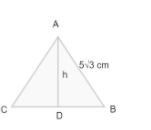
Find the altitude of an equilateral triangle of side $5\sqrt{3}cm$ .
( a ) 7.5 cm
( b ) 12.5 cm
( c ) 9.5 cm
( d ) 8.5 cm
Answer
575.1k+ views
Hint: As given triangle is equilateral thus all sides will be equal and will form two right angle triangles when altitude drawn from point A to the base CB, then by using Pythagoras theorem we can evaluate height of triangle.
Complete step-by-step answer:

Equilateral triangle is a triangle whose all sides are equal and each angle measure is equal to ${{60}^{{}^\circ }}$ .
Now, also as all sides of a triangle are equal that is AB = BC = AC then it is obvious all angles are also of the same measure as there is a theorem in triangles, that the angle opposite to two equal sides of a triangle are equal.
Now, in question it is given that we have an equilateral triangle whose measure of side is equal to $5\sqrt{3}cm$. So, from figure we can say that sides of triangle $\vartriangle ABC$ are equal to $5\sqrt{3}cm$ that is $AB\text{ }=\text{ }BC\text{ }=\text{ }AC=5\sqrt{3}cm$ and we have to calculate the altitude that is height of the triangle. Height of the triangle is the perpendicular distance from point A to the base of triangle BC. Let height of triangle $\vartriangle ABC$ be AD = h .
Now, as AD is perpendicular to the base BC then, it will also be a perpendicular bisector of length BC that is CD = DB .
So if CB = $5\sqrt{3}cm$
Then CD = DB = $\dfrac{5\sqrt{3}}{2}cm$
Now, $\vartriangle ADB$ is the right angle triangle that is Pythagora's theorem can be applied here to evaluate the value of h.
Pythagoras theorem is applicable for right angled triangle with base b , height d and hypotenuse h ans states that $h=\sqrt{{{d}^{2}}+{{b}^{2}}}$
So, in triangle $\vartriangle ADB$, height is h , base is $\dfrac{5\sqrt{3}}{2}cm$ and hypotenuse is $5\sqrt{3}cm$then
Putting all values in $h=\sqrt{{{d}^{2}}+{{b}^{2}}}$we get
$5\sqrt{3}cm$ = $5\sqrt{3}=\sqrt{{{h}^{2}}+{{\left( 2.5\sqrt{3} \right)}^{2}}}$
On simplifying, we get
\[{{\left( 5\sqrt{3} \right)}^{2}}={{h}^{2}}+{{\left( 2.5\sqrt{3} \right)}^{2}}\]
\[{{h}^{2}}={{\left( 5\sqrt{3} \right)}^{2}}-{{\left( 2.5\sqrt{3} \right)}^{2}}\]
\[{{h}^{2}}={{5}^{2}}\cdot 3-{{\left( 2.5 \right)}^{2}}\cdot 3\]
\[{{h}^{2}}=25\cdot 3-6.25\cdot 3\]
\[{{h}^{2}}=75-18.25\]
\[{{h}^{2}}=56.25\]
\[h=\sqrt{56.25}\]
On solving, we get
h = 7.5 cm
Hence, option ( a ) is correct .
Note: While solving numerical based triangles always remember the concept and formulas of Pythagoras and equilateral triangles. As calculation is very complex while solving equations using Pythagoras theorem, try to avoid calculation mistakes.
Complete step-by-step answer:

Equilateral triangle is a triangle whose all sides are equal and each angle measure is equal to ${{60}^{{}^\circ }}$ .
Now, also as all sides of a triangle are equal that is AB = BC = AC then it is obvious all angles are also of the same measure as there is a theorem in triangles, that the angle opposite to two equal sides of a triangle are equal.
Now, in question it is given that we have an equilateral triangle whose measure of side is equal to $5\sqrt{3}cm$. So, from figure we can say that sides of triangle $\vartriangle ABC$ are equal to $5\sqrt{3}cm$ that is $AB\text{ }=\text{ }BC\text{ }=\text{ }AC=5\sqrt{3}cm$ and we have to calculate the altitude that is height of the triangle. Height of the triangle is the perpendicular distance from point A to the base of triangle BC. Let height of triangle $\vartriangle ABC$ be AD = h .
Now, as AD is perpendicular to the base BC then, it will also be a perpendicular bisector of length BC that is CD = DB .
So if CB = $5\sqrt{3}cm$
Then CD = DB = $\dfrac{5\sqrt{3}}{2}cm$
Now, $\vartriangle ADB$ is the right angle triangle that is Pythagora's theorem can be applied here to evaluate the value of h.
Pythagoras theorem is applicable for right angled triangle with base b , height d and hypotenuse h ans states that $h=\sqrt{{{d}^{2}}+{{b}^{2}}}$
So, in triangle $\vartriangle ADB$, height is h , base is $\dfrac{5\sqrt{3}}{2}cm$ and hypotenuse is $5\sqrt{3}cm$then
Putting all values in $h=\sqrt{{{d}^{2}}+{{b}^{2}}}$we get
$5\sqrt{3}cm$ = $5\sqrt{3}=\sqrt{{{h}^{2}}+{{\left( 2.5\sqrt{3} \right)}^{2}}}$
On simplifying, we get
\[{{\left( 5\sqrt{3} \right)}^{2}}={{h}^{2}}+{{\left( 2.5\sqrt{3} \right)}^{2}}\]
\[{{h}^{2}}={{\left( 5\sqrt{3} \right)}^{2}}-{{\left( 2.5\sqrt{3} \right)}^{2}}\]
\[{{h}^{2}}={{5}^{2}}\cdot 3-{{\left( 2.5 \right)}^{2}}\cdot 3\]
\[{{h}^{2}}=25\cdot 3-6.25\cdot 3\]
\[{{h}^{2}}=75-18.25\]
\[{{h}^{2}}=56.25\]
\[h=\sqrt{56.25}\]
On solving, we get
h = 7.5 cm
Hence, option ( a ) is correct .
Note: While solving numerical based triangles always remember the concept and formulas of Pythagoras and equilateral triangles. As calculation is very complex while solving equations using Pythagoras theorem, try to avoid calculation mistakes.
Recently Updated Pages
Master Class 9 Social Science: Engaging Questions & Answers for Success

Master Class 9 Science: Engaging Questions & Answers for Success

Master Class 9 English: Engaging Questions & Answers for Success

Master Class 9 Maths: Engaging Questions & Answers for Success

Master Class 9 General Knowledge: Engaging Questions & Answers for Success

Class 9 Question and Answer - Your Ultimate Solutions Guide

Trending doubts
Which places in India experience sunrise first and class 9 social science CBSE

Fill the blanks with the suitable prepositions 1 The class 9 english CBSE

Write the 6 fundamental rights of India and explain in detail

Difference Between Plant Cell and Animal Cell

What is pollution? How many types of pollution? Define it

What is the Full Form of ISI and RAW




